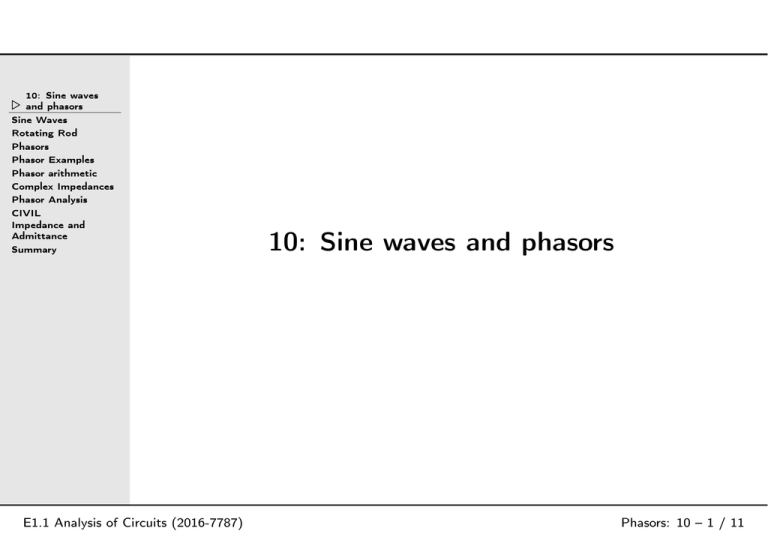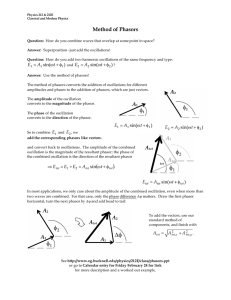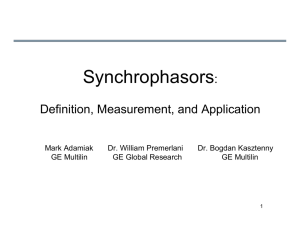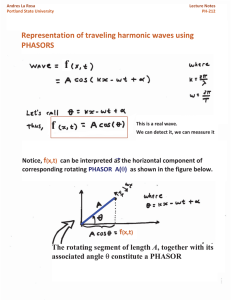handouts
advertisement

10: Sine waves ⊲ and phasors Sine Waves Rotating Rod Phasors Phasor Examples Phasor arithmetic Complex Impedances Phasor Analysis CIVIL Impedance and Admittance Summary E1.1 Analysis of Circuits (2016-7787) 10: Sine waves and phasors Phasors: 10 – 1 / 11 Sine Waves Usually differentiation changes the shape of a waveform. 1 0 -1 0 For bounded waveforms there is only one exception: v(t) = sin t ⇒ dv dt = cos t same shape but with a time shift. 1 2 t 3 4 1 2 t 3 4 5 0 -5 0 1 0 -1 0 5 10 15 10 15 t sin t completes one full period every time t increases by 2π. 1 dv/dt ⊲ di For inductors and capacitors i = C dv and v = L dt dt so we need to differentiate i(t) and v(t) when analysing circuits containing them. v(t) 10: Sine waves and phasors Sine Waves Rotating Rod Phasors Phasor Examples Phasor arithmetic Complex Impedances Phasor Analysis CIVIL Impedance and Admittance Summary 0 -1 0 5 t sin 2πf t makes f complete repetitions every time t increases by 1; this gives a frequency of f cycles per second, or f Hz. We often use the angular frequency , ω = 2πf instead. ω is measured in radians per second. E.g. 50 Hz ≃ 314 rad.s−1 . E1.1 Analysis of Circuits (2016-7787) Phasors: 10 – 2 / 11 Rotating Rod 10: Sine waves and phasors Sine Waves Rotating Rod Phasors Phasor Examples Phasor arithmetic Complex Impedances Phasor Analysis CIVIL Impedance and Admittance Summary ⊲ A useful way to think of a cosine wave is as the projection of a rotating rod onto the horizontal axis. For a unit-length rod, the projection has length cos θ. If the rod is rotating at a speed of f revolutions per second, then θ increases uniformly with time: θ = 2πf t. The only difference between cos and sin is the starting position of the rod: 1 1 0 0 -1 0 5 10 t v = cos 2πf t 15 -1 0 5 10 v = sin 2πf t = cos 2πf t − sin 2πf t lags cos 2πf t by 90◦ (or π2 radians) because its peaks occurs a cycle later (equivalently cos leads sin) . E1.1 Analysis of Circuits (2016-7787) 15 t π 2 1 4 of Phasors: 10 – 3 / 11 Phasors 10: Sine waves and phasors Sine Waves Rotating Rod Phasors Phasor Examples Phasor arithmetic Complex Impedances Phasor Analysis CIVIL Impedance and Admittance Summary ⊲ If the rod has length A and starts at an angle φ then the projection onto the horizontal axis is A cos (2πf t + φ) = A cos φ cos 2πf t − A sin φ sin 2πf t = X cos 2πf t − Y sin 2πf t At time t = 0, the tip of the rod has coordinates (X, Y ) = (A cos φ, A sin φ). If we think of the plane as an Argand Diagram (or complex plane), then the complex number X + jY corresponding to the tip of the rod at t = 0 is called a phasor . √ The magnitude of the phasor, A = X 2 + Y 2 , gives the amplitude (peak value) of the sine wave. Y , gives the phase shift relative The argument of the phasor, φ = arctan X to cos 2πf t. If φ > 0, it is leading and if φ < 0, it is lagging relative to cos 2πf t. E1.1 Analysis of Circuits (2016-7787) Phasors: 10 – 4 / 11 Phasor Examples 10: Sine waves and phasors Sine Waves Rotating Rod Phasors Phasor Examples Phasor arithmetic Complex Impedances Phasor Analysis CIVIL Impedance and Admittance Summary ⊲ V = 1, f = 50 Hz v(t) = cos 2πf t 1 0 -1 0 0.02 0.04 0.06 0.04 0.06 t V = −j v(t) = sin 2πf t 1 0 -1 0 0.02 t V = −1 − 0.5j = 1.12∠ − 153◦ v(t) = − cos 2πf t + 0.5 sin 2πf t = 1.12 cos (2πf t − 2.68) V = X + jY v(t) = X cos 2πf t − Y sin 2πf t Beware minus sign. V = A∠φ = Aejφ v(t) = A cos (2πf t + φ) A phasor represents an entire waveform (encompassing all time) as a single complex number. We assume the frequency, f , is known. A phasor is not time-varying, so we use a capital letter: V . A waveform is time-varying, so we use a small letter: v(t). Casio: Pol(X, Y ) → A, φ, Rec(A, φ) → X, Y . Saved → X & Y mems. E1.1 Analysis of Circuits (2016-7787) Phasors: 10 – 5 / 11 [Algebraic Phasor↔Waveform Mapping] A phasor is a complex number, V , that uniquely defines a waveform, v(t), via the mapping V = Aejφ ←→ v(t) = A cos (2πf t + φ). It is sometimes conveninet to give an algebraic formula for this. For the direction V −→ v(t) the mapping is easy: v(t) = ℜ V ej2πf t = 1 2 (V + V ∗ ) cos 2πf t + 21 j (V − V ∗ ) sin 2πf t. The reverse mapping, V ←− v(t) is a bit more complicated and we use a technique that you will also use in the Maths of Fourier transforms. The mapping is given by Z 1 f v(t)e−j2πf t dt. V = 2f 0 To confrm that this is true, we can substitute v(t) = A cos (2πf t + φ) and do the integration: 2f Z 1 f −j2πf t v(t)e dt = Af Z Af Z 0 1 f 0 = 1 f 0 = jφ Ae E1.1 Analysis of Circuits (2016-7787) j(2πf t+jφ −j2πf t−jφ e +e e−j2πf t dt Z ejφ + e−j4πf t−jφ dt = Aejφ + Af e−jφ Af e−jφ −j4πf t e + −j4πf h i1 f 0 jφ = Ae 1 f e−j4πf t dt 0 Af e−jφ −j4π e − 1 = Aejφ + −j4πf Phasors: 10 – note 1 of slide 5 Phasor arithmetic 10: Sine waves and phasors Sine Waves Rotating Rod Phasors Phasor Examples Phasor arithmetic Complex Impedances Phasor Analysis CIVIL Impedance and Admittance Summary ⊲ Phasors Waveforms V = X + jY v(t) = X cos ωt − Y sin ωt where ω = 2πf . aV a × v(t) = aX cos ωt − aY sin ωt V1 + V2 v1 (t) + v2 (t) Adding or scaling is the same for waveforms and phasors. V̇ = (−ωY ) + j (ωX) = jω (X + jY ) = jωV dv dt = −ωX sin ωt − ωY cos ωt = (−ωY ) cos ωt − (ωX) sin ωt Differentiating waveforms corresponds to multiplying phasors by jω. Rotate anti-clockwise 90◦ and scale by ω = 2πf . E1.1 Analysis of Circuits (2016-7787) Phasors: 10 – 6 / 11 Complex Impedances 10: Sine waves and phasors Sine Waves Rotating Rod Phasors Phasor Examples Phasor arithmetic Complex Impedances Phasor Analysis CIVIL Impedance and Admittance Summary ⊲ Resistor: v(t) = Ri(t) ⇒ V = RI ⇒ V I =R ⇒ V I = jωL ⇒ V I = Inductor: di ⇒ V = jωLI v(t) = L dt Capacitor: i(t) = C dv dt ⇒ I = jωCV 1 jωC For all three components, phasors obey Ohm’s law if we use the complex 1 as the “resistance” of an inductor or capacitor. impedances jωL and jωC If all sources in a circuit are sine waves having the same frequency, we can do circuit analysis exactly as before by using complex impedances. E1.1 Analysis of Circuits (2016-7787) Phasors: 10 – 7 / 11 Phasor Analysis (1) Find capacitor complex impedance 1 1 = 6.28j×10 Z = jωC −4 = −1592j (2) Solve circuit with phasors Z VC = V × R+Z −1592j 1000−1592j = −10j × = −4.5 − 7.2j = 8.47∠ − 122◦ vC = 8.47 cos (ωt − 122◦ ) 10 v R ⊲ Given v = 10 sin ωt where ω = 2π × 1000, find vC (t). vR vC 0 C 10: Sine waves and phasors Sine Waves Rotating Rod Phasors Phasor Examples Phasor arithmetic Complex Impedances Phasor Analysis CIVIL Impedance and Admittance Summary -10 0 0.5 1 t (ms) 1.5 2 (3) Draw a phasor diagram showing KVL: V = −10j VC = −4.5 − 7.2j VR = V − VC = 4.5 − 2.8j = 5.3∠ − 32◦ Phasors add like vectors E1.1 Analysis of Circuits (2016-7787) Phasors: 10 – 8 / 11 [Differential Equation Analysis] To solve the problem form the previous slide without using phasors, we define i to be the current flowing C clockwise and use the capacitor equation i = C dv . dt From KVL, we have v = vR + vC = iR + vC . Differentiating and applying the capacitor equation gives dv dt di = 10ω cos ωt = R dt + 1 i. C We need to find the particular integral for the above equation. To do so, we guess that the answer will be of the form i = A cos ωt + B sin ωt and substitute it into the equation (multiplied by C). 10Cω cos ωt = RC (−Aω sin ωt + Bω cos ωt) + (A cos ωt + B sin ωt) = (A + RCBω) cos ωt + (B − RCAω) sin ωt which gives two siultaneous equations: A + RCωB = 10Cω and −RCωA + B = 0. Substituting values for R, C and ω gives A + 0.628B = 0.00628 and −0.628A + B = 0. Solving these simultaneous equations gives A = 4.5 mA and B = 2.8 mA. The resistor voltage is therefore vR = iR = 4.5 cos ωt + 2.8 sin ωt and therefore, from KVL, the capacitor votage is vC = v − vR = −4.5 cos ωt + 7.2 sin ωt. Thus we get the same answer as using phasors but with more work even for a simple circuit like this. For more complicated circuits the difference is much much bigger. E1.1 Analysis of Circuits (2016-7787) Phasors: 10 – note 1 of slide 8 CIVIL 10: Sine waves and phasors Sine Waves Rotating Rod Phasors Phasor Examples Phasor arithmetic Complex Impedances Phasor Analysis CIVIL Impedance and Admittance Summary ⊲ Capacitors: i = C dv dt ⇒ I leads V di ⇒ V leads I Inductors: v = L dt Mnemonic: CIVIL = “In a capacitor I lead V but V leads I in an inductor”. COMPLEX ARITHMETIC TRICKS: (1) j × j = −j × −j = −1 (2) 1j = −j (3) a + jb = r∠θ = √ rejθ where r = a2 + b2 and θ = arctan ab (±180◦ if a < 0) (4) r∠θ = rejθ = (r cos θ) + j (r sin θ) a∠θ = ab ∠ (θ − φ). (5) a∠θ × b∠φ = ab∠ (θ + φ) and b∠φ Multiplication and division are much easier in polar form. (6) All scientific calculators will convert rectangular to/from polar form. Casio fx-991 (available in all exams except Maths) will do complex arithmetic (+, −, ×, ÷, x2 , x1 , |x|, x∗ ) in CMPLX mode. Learn how to use this: it will save lots of time and errors. E1.1 Analysis of Circuits (2016-7787) Phasors: 10 – 9 / 11 Impedance and Admittance 10: Sine waves and phasors Sine Waves Rotating Rod Phasors Phasor Examples Phasor arithmetic Complex Impedances Phasor Analysis CIVIL Impedance and Admittance Summary ⊲ For any network (resistors+capacitors+inductors): (1) Impedance = Resistance + j× Reactance Z = R + jX (Ω) |Z|2 = R2 + X 2 ∠Z = arctan X R 1 = Conductance + j× Susceptance (2) Admittance = Impedance Y = Z1 = G + jB Seimens (S) 1 2 2 ∠Y = −∠Z = arctan B |Y |2 = |Z| 2 = G + B G Note: Y = G + jB = So G 1 1 R = = 2 Z R+jX R +X 2 R R = R2 +X 2 = |Z|2 B= Beware: G 6= E1.1 Analysis of Circuits (2016-7787) 1 R −X R2 +X 2 = + j R2−X +X 2 −X |Z|2 unless X = 0. Phasors: 10 – 10 / 11 Summary 10: Sine waves and phasors Sine Waves Rotating Rod Phasors Phasor Examples Phasor arithmetic Complex Impedances Phasor Analysis CIVIL Impedance and Admittance Summary ⊲ • Sine waves are the only bounded signals whose shape is unchanged by differentiation. • Think of a sine wave as the projection of a rotating rod onto the horizontal (or real) axis. ◦ A phasor is a complex number representing the length and position of the rod at time t = 0. ◦ If V = a + jb = r∠θ = rejθ , then jωt v(t) = a cos ωt − b sin ωt = r cos (ωt + θ) = ℜ V e ◦ The angular frequency ω = 2πf is assumed known. • If all sources in a linear circuit are sine waves having the same frequency, we can use phasors for circuit analysis: 1 ◦ Use complex impedances: jωL and jωC ◦ Mnemonic: CIVIL tells you whether I leads V or vice versa (“leads” means “reaches its peak before”). ◦ Phasors eliminate time from equations ,, converts simultaneous differential equations into simultaneous linear equations ,,,. ◦ Needs complex numbers / but worth it. see Hayt Chapter 10 E1.1 Analysis of Circuits (2016-7787) Phasors: 10 – 11 / 11


![If F = (2.5+ j3.2) find P P [F]= 4.06cos(ω t + 52°) 2.5+ j3.2 = 2.5 + 3.2](http://s2.studylib.net/store/data/018459509_1-fbb455a35b72964a26b5dd36b7185505-300x300.png)
